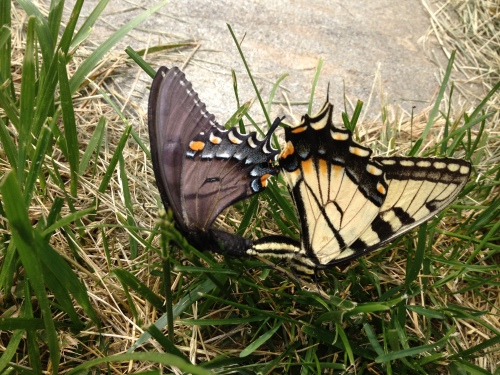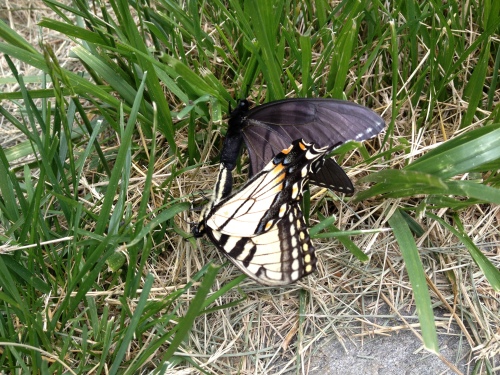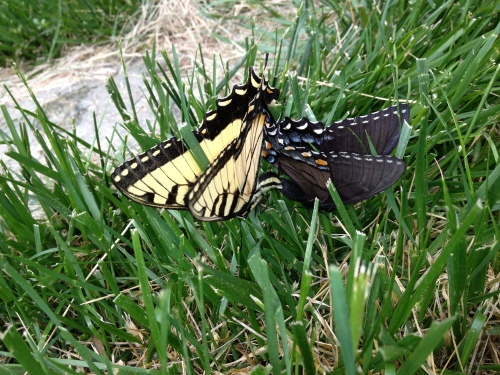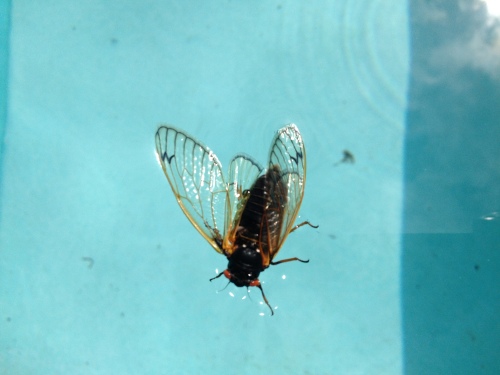 I haven’t had much that I want to share with the world lately. A lot going on and very busy, but more the kind of thing you write in a journal. Today, however, I saw something I thought was pretty interesting, and beautiful. In our yard, two butterflies mating. Something I’d never seen before, or never quite like this. What do you know?
I haven’t had much that I want to share with the world lately. A lot going on and very busy, but more the kind of thing you write in a journal. Today, however, I saw something I thought was pretty interesting, and beautiful. In our yard, two butterflies mating. Something I’d never seen before, or never quite like this. What do you know? 
I won’t get too graphic, but let’s just say they were at it for a long time, and willingly posed for me as I tried various angles to get the best light. Well, maybe they weren’t really so willing and it was more that they were stuck in that position, because they did startle a few times and ruffle their wings in a panicked way, or as if they hoped to scare me off. But they’d calm right down again and be peaceful, no matter how close I got. It didn’t seem like they could just disengage with what they were doing—it seemed a necessarily lengthy process that they either couldn’t or wouldn’t interrupt. They were very connected. It was as if great secrets, delicate treasures, were being carefully passed between them, and they did not dare to disturb the transportation of them. Or it was as if they were saying, Good things take time, stupid human! We go slow and enjoy the process (yeah, really slow). We make a good thing last. OK, maybe so, but it did not look passionate. 
As I watched, I wondered which was the male and which the female. If butterflies were like birds, I guessed the more colorful one would be the male, the yellow one. I looked closer, and sure enough, the yellow one, as you can see, was doing the probing, was inside the black one (rather deeply, the end of its body entirely inserted into the end of the other one’s body). I thought, OK, now I need to go in the house and check online to see if that’s right (t had to be, didn’t it?). And what kind of butterfly was this? The name for it was on the tip of my tongue… The yellow one at least. I wouldn’t have pretended to know the name of the black one, or to know they were related. And all of a sudden my mind was full of other butterfly questions—is this the way it is for all butterflies, the male and female different colors? If so, is the orange-and-black Monarch a male or a female, or are all Monarchs orange-and-black?…

[Yes, as it turns out, the yellow one’s male and the dark one female—they are Eastern Swallowtails. Seems the female can be dark or yellow, but the males are always yellow. No, Monarchs do not differ in color between male and female; both are orange-and-black and look so similar I can’t tell the difference between pictures of the two.] 
Butterflies have always fascinated me. When we were kids we liked to catch the yellow-black-and-white striped caterpillars that make shiny jade-green chrysalises edged in gold and then turn into orange-and-black Monarch butterflies (how do they change to such different colors?). We’d find them up on my Uncle Wally’s hill across the road from our lake, crawling on and munching on the milkweed growing in the meadow of the Hill, or we’d find one of those beautiful jeweled chrysalises hanging from the log fence rails. Wed catch the caterpillars or carefully pull of a strip of bark from the log rail and take either the caterpillar or the chrysalis home and put them in a jar with a lid with holes poked in it.
If it was a chrysalis, we just waited for it to hatch.
If it was a caterpillar, we put a supply of milkweed in there with it and a stick to climb so that when it was ready, it would have a way to climb up and attach to something to make its chrysalis. We’d keep check on it, watching to see the amazing transformation from caterpillar to chrysalis, the way it mummified itself and seemed to liquefy then, turning different colors, from stripes of yellow, black and white to green and then as the day passed, we’ see it begin to darken and realize the chrysalis was a clear shell—because we’d see black and orange and know from previous years that it was the black and orange of a scrunched up Monarch butterfly in there. And soon it would hatch.
The hatching was incredible, too. This shaky little black-bodied butterfly came out, all long skinny elbows and knees (or whatever you call those angular limb parts) as butterfly legs are. The wing were rumpled up, wrinkled, folded, but as the butterly flapped them, they unfolded. We had to be careful to take the butterfly out of the jar and give it room for its expanding wings, so they wouldn’t hit anything and be damaged, fragile things (yes, we were to blame for some deformed butterfly wings and had learned this the hard way). We’d give the butterfly some sugar water in the lid of a jar and he’d (she’d?) unfurl his long, skinny black spiral tongue, like a long perfectly curled hair or a tendril, and stick the end of it in the sugar water and drink. My mom it needed the sugar water to pump up the viens in its wings and we believed her since the wings grew, unfolded, straightened out—much the way an inflatable water raft does when you take it out of the box and blow it up.
It would slowly flap and flap those wings, pumping them up, airing them, drying them out, making them lightweight and rigid and strong, and then… and then if you could be as patient as that butterfly, you would get to see it take its first flight. And we’d clap and say, “Yay!” and be so delighted to see the simple perfection of it. And we were somehow, foolishly, proud to have been a part of it. I felt like a parent–I’d watched after and protected this creature, fed it, and was now seeing it off into the world. But the truth of it was, I’d done nothing, I knew. Well, nothing to damage it, that is. Nature had done the rest. Perfectly.











